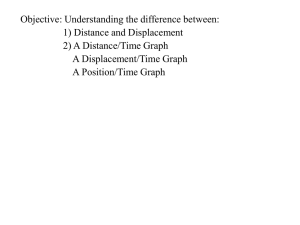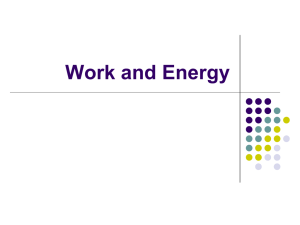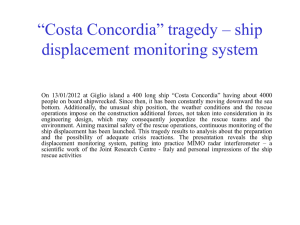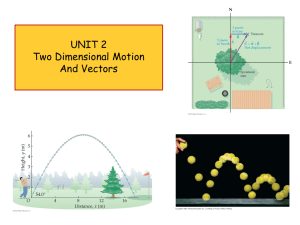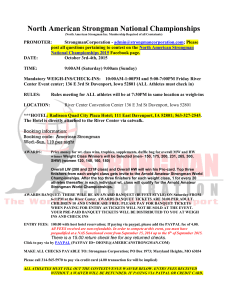Human Power Lab
advertisement
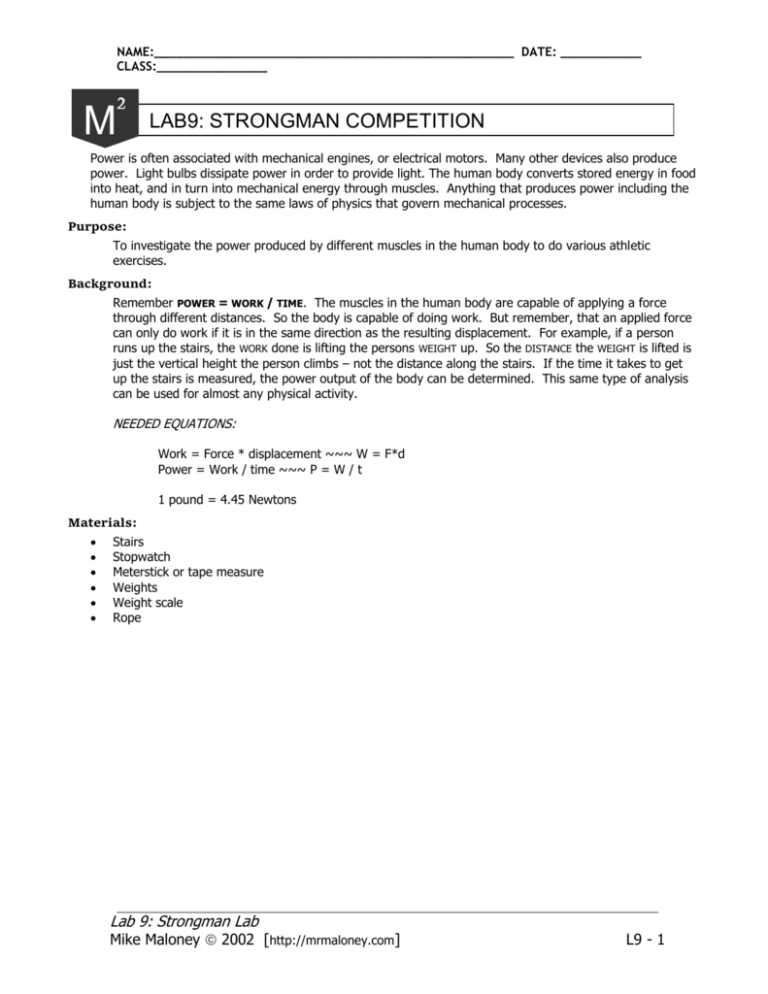
NAME:_________________________________________________ DATE: ___________ CLASS:_______________ 2 M LAB9: STRONGMAN COMPETITION Power is often associated with mechanical engines, or electrical motors. Many other devices also produce power. Light bulbs dissipate power in order to provide light. The human body converts stored energy in food into heat, and in turn into mechanical energy through muscles. Anything that produces power including the human body is subject to the same laws of physics that govern mechanical processes. Purpose: To investigate the power produced by different muscles in the human body to do various athletic exercises. Background: Remember POWER = WORK / TIME. The muscles in the human body are capable of applying a force through different distances. So the body is capable of doing work. But remember, that an applied force can only do work if it is in the same direction as the resulting displacement. For example, if a person runs up the stairs, the WORK done is lifting the persons WEIGHT up. So the DISTANCE the WEIGHT is lifted is just the vertical height the person climbs – not the distance along the stairs. If the time it takes to get up the stairs is measured, the power output of the body can be determined. This same type of analysis can be used for almost any physical activity. NEEDED EQUATIONS: Work = Force * displacement ~~~ W = F*d Power = Work / time ~~~ P = W / t 1 pound = 4.45 Newtons Materials: Stairs Stopwatch Meterstick or tape measure Weights Weight scale Rope Lab 9: Strongman Lab Mike Maloney 2002 [http://mrmaloney.com] L9 - 1 NAME:_________________________________________________ DATE: ___________ CLASS:_______________ Procedure: 1. In this lab, the following activities will be tested and compared. Doing push ups Running up stairs Curling a Mass A. Dragging a weight 2. First the group must decide which member(s) will be performing each activity. All members should perform all the activities, but if all members are unable to, at least one member should perform all of them. 3. Once it is decided who will perform the activities, the group must decide how each activity can be tested, and what is actually being tested. Several values must be known in order to find the power of an activity. What is the force being applied Over what displacement is it being applied Is the force causing the displacement, and if so what is its direction relative to the displacement How long does it take for the force to produce the displacement If you are having trouble determining what these values are or how to test for them, ask your teacher for some help. Try to come up with some ideas before going to the teacher. Write down your final process in the space provided under Testing Procedures. 4. Before testing begins, write down your hypothesis concerning which activity will require the most power. Rank the activities 1-4, 1 being the most powerful, 4 being the least. 5. Test each activity for each person in the lab group. Measure the applied force, displacement, and time for each activity and record this data in the data table. 6. After the first activity is completed, move on to the second activity and record force, displacement, and time data for each lab member. Lab 9: Strongman Lab Mike Maloney 2002 [http://mrmaloney.com] L9 - 2 NAME:_________________________________________________ DATE: ___________ CLASS:_______________ 7. Repeat the procedure again for the 3rd and 4th activities. D: DRAGGING C: CURLING B: STAIRS A: PUSHUPS 8. Use the force, displacement and time data to calculate the power supplied by the human body to complete each activity. Testing Procedures: <<< complete in your lab notebook >>> Lab 9: Strongman Lab Mike Maloney 2002 [http://mrmaloney.com] L9 - 3 NAME:_________________________________________________ DATE: ___________ CLASS:_______________ Hypothesis: Data: Student 1 Exercise A B C Student 2 D A B C D Force (N) Distance (m) Time (s) Work (J) Power (W) Student 3 Exercise A B C Student 4 D A B C D Force (N) Distance (m) Time (s) Work (J) Power (W) Calculations: Lab 9: Strongman Lab Mike Maloney 2002 [http://mrmaloney.com] L9 - 4 NAME:_________________________________________________ DATE: ___________ CLASS:_______________ Analysis: (answer the following questions in your lab report) 1. In which activity was the most power produced? Which muscle group(s) was used primarily in this activity? 2. Which activity produced the least power? Which muscle group(s) were used in this activity? 3. How did your answers to 1 and 2 compare to your hypothesis? Do your results make sense? 4. Did the activity that used the largest force result in the largest power produced? Explain how a large force can result in a small power output. 5. We often use simple machines such as inclined planes, pulleys and levers to make work easier. Does this make us more powerful? Explain why or why not. 6. There is also something called electrical power, which we will learn later in the year. Just as a comparison, could any of the performances light a 60-Watt light-bulb? And if so, how many light-bulbs could it light? 7. Use Microsoft Excel or a similar computer program to produce graphs comparing and contrasting your data. For this case, you should use BAR GRAPHS. Make a graph comparing the Work and a graph comparing the Power for the Student who did all 4 events, and make a graph comparing the Work and a graph comparing the Power of the various students for the one event they did in common. You should have a total of 4 graphs, 2 Work and 2 Power. Lab 9: Strongman Lab Mike Maloney 2002 [http://mrmaloney.com] L9 - 5 NAME:_________________________________________________ DATE: ___________ CLASS:_______________ NOTES TO TEACHERS ESTIMATED TIME: 1 class period (40-60 min depending on the size of the lab groups) WHEN IN UNIT I usually do this lab right after I introduce students to the concepts of WORK and POWER, usually the next class. DISCLAIMER As you can see, the data taken in the lab is not going to be perfect. These ways are not completely accurate ways to measure power and work. For example doing curls and pushups we just count the work done pulling/pushing up but the time is the total time up and down so that is not completely correct, but the purpose is not to get perfect numbers, but rather to do a fun lab where students can practically use and understand work and power, and see how if manifests itself through our muscles, and then learn techniques to compare and contrast the data. The results usually do rank in the correct order: legs, back, triceps, biceps however, giving them some qualitative validity. DOING THE LAB As you can see, this lab involves physical activity. I usually do not make every student physically compete in every event if they do not feel comfortable. Some students do not want to do push-up, or run, and many students do not like others knowing their weight. Therefore I usually make lab groups where each group will have at least one student who will do all the exercises, and the others will do the ones they feel comfortable with. It also helps to let the students know what day the lab will take place on so they can wear appropriate clothing. The results of this lab may not be extremely precise, but they should be good enough to compare the power output of different muscle groups, as well as give the student practice on determining WORK and POWER for real life situations in a fun and relaxed way. PROCEDURES This lab is designed to have students come up with their own procedures for determining the WORK and POWER of each exercise. There are three ways that I have accomplished this – depending on the level of class. HARD (Honors level): Have students come up with the procedures all by themselves in their lab groups or as a pre-lab exercise. Have them check their procedures with the teacher to make sure they will give correct results. Different lab groups may have different procedures. If done during class, this may take up to 20 minutes. You could also give them the materials they can use to create their procedures to make sure you would have everything they need. MEDUIM (college prep level): Hold a class discussion in which the class and teacher decide on the procedures to determine the WORK and POWER of each exercise. Here the students will write down the procedures and all use the same ones. EASY (college prep level): Simply give the students the procedures that they should use to determine the WORK and POWER of each exercise. EXTENSIONS At the end you could also have the students get data from other groups and analyze all of the data from the class, where they could calculate overall averages, high, lows, etc. Procedures that I have used are summarized on the next page. ============================================================================ Lab 9: Strongman Lab Mike Maloney 2002 [http://mrmaloney.com] L9 - 6 NAME:_________________________________________________ DATE: ___________ CLASS:_______________ A) Push-Ups The muscles doing the applying in this case are your pectorals (chest) and your triceps. The force to do a pushup is due to gravity, but it is not the entire weight of the student. To figure out how much the arms and chest have to push up we can use a bathroom scale. Get down in the push-up position, and place hands on top of a bathroom scale, rather than the floor. The reading on the scale is the size of the force that the arms must apply when doing a push-up (pushup weight). To measure the distance traveled while doing a push-up, measure the shoulder height of the student in the “up” pushup position. Then measure the height in the “down position.” This position is when your upper arms are parallel with the ground, or when the chest is on the ground depending on how the pushup is being done. The difference between these two values is the displacement of your body during a push-up. Since we are doing 10 push-ups, the total displacement will be 10 times this value. To measure the time of doing the push-ups, just time how long it takes to do 10 push-ups. Again this is not perfect, it does not take into account the time going back down, so if you would like to add a fudge factor (maybe –30% of total time) that would be OK. B) Stair Climbing For the stair climbing part, we will be climbing 1 floor worth of stairs. Here the force being applied in the direction of motion is just equal to the weight of the student. This can be measured using a bathroom scale. The distance traveled is a little tricky. Gravity acts straight down, so the displacement that is parallel to motion is actually just the height of the stairs climbed. We can find this by measuring the height of one stair, and then multiplying it by the total number of stairs climbed. Again, a stopwatch can measure the time. C) Curling a Mass Curling is lifting a weight using only your biceps. The weight starts at your hip with your arm parallel to your body. It is then “curled” up until it is next to your shoulder, again parallel to your body. The force that is being applied her to produce motion has to be equal to the weight of the mass. The displacement is going to be just the change in height of the mass as you lift it. To do this, hold the mass in the start position and measure how high it is off the ground. Measure it again in the finish position. The difference between the two is the displacement of the mass. We will do 10 curls, so the total displacement is 10 times this displacement. The time can be measured using a stopwatch. Again this is not perfect, it does not take into account the time going back down, so if you would like to add a fudge factor (maybe –30% of total time) that would be OK. D) Dragging a Mass Do not use your legs. This should be done from a stationary, seated position on the floor (may want to use a blanket or towel to sit on depending on the state of your school floors). The muscles used to drag a mass are your shoulders back and upper arms. To set up this experiment, o Tape off a 7-meter course. o Tie a rope to a backpack and place about 40 pounds of weights inside it. o Place the backpack at one end of the course, and lay the rope out until it reaches the other side of the course. o The participant should sit at the end where the rope is, about 1 meter behind the tape mark. o Pull in the rope hand over hand until the bag crosses the finish line. o A timer should measure the time from the beginning of the first pull until the front of the bag crosses the finish line. The displacement here is 7 meters, but can be anything. The force needed to move the mass is equal to the kinetic frictional force between the mass and the floor. To find this, attach a spring scale(s) to the bag and drag it. When it is dragged at a constant speed, a force should measure on the scale(s). This force is equal to the kinetic frictional force. Due to time considerations, I may measure this value for the students and give it to them in advance. The time is again the time on the stopwatch. Lab 9: Strongman Lab Mike Maloney 2002 [http://mrmaloney.com] L9 - 7
